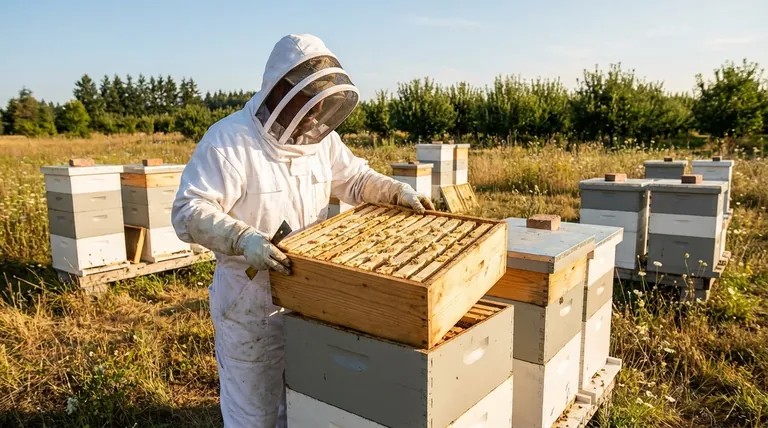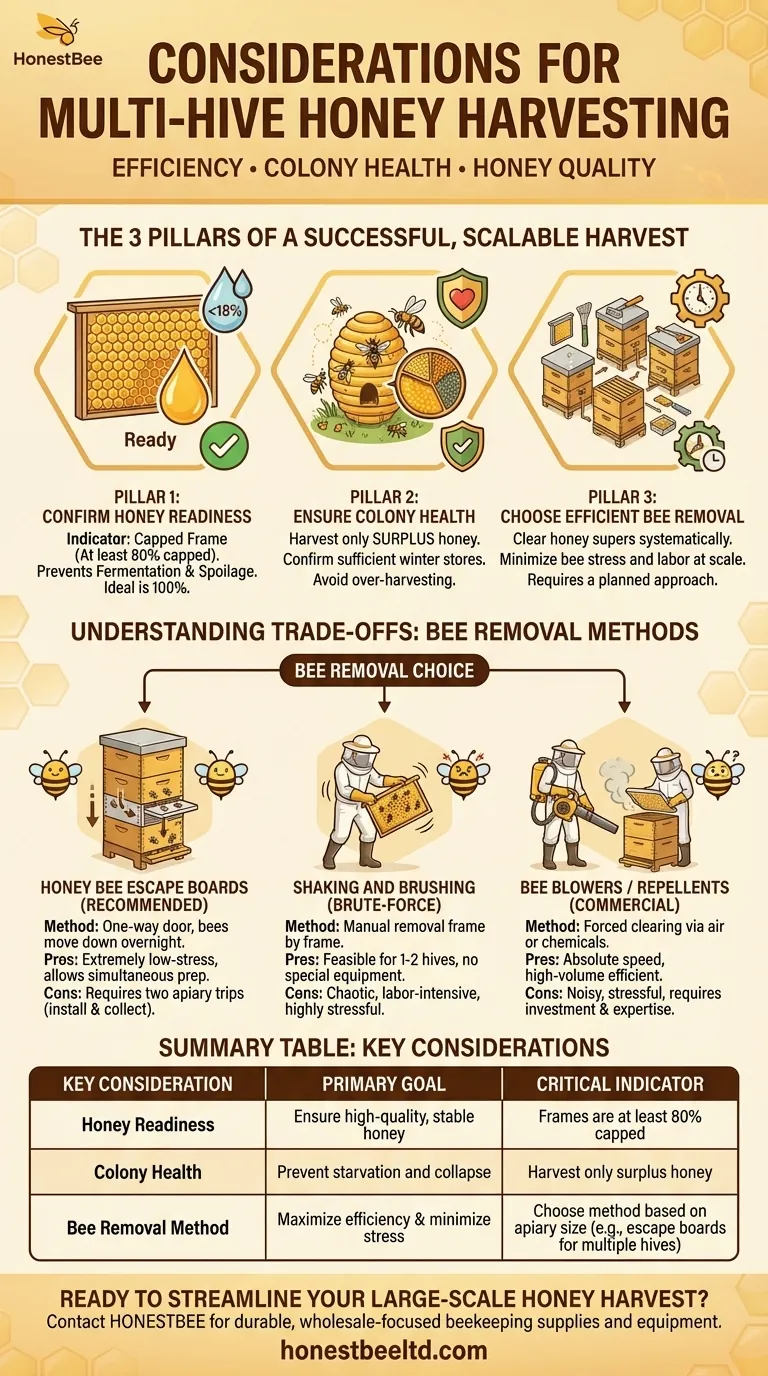When harvesting honey from multiple hives, your primary considerations are efficiency, colony health, and honey quality. The key is to select a bee-removal method, such as using bee escape boards, that allows you to work on all hives simultaneously. This must be balanced with confirming the honey is ripe—indicated by at least 80% of the cells being capped—and ensuring you leave sufficient stores for the colony's survival.
Your goal is to move from a single-hive mentality to a systematic process. Success at scale depends on choosing a method that minimizes bee stress and your own labor while maximizing the quality of your harvest.

The Pillars of a Multi-Hive Harvest
A successful, scalable harvest rests on three core principles. Overlooking any one of them can compromise your honey, your bees, or your time.
Pillar 1: Confirming Honey is Ready
Before you intervene, you must verify the bees have finished their work. This is non-negotiable for ensuring high-quality, stable honey.
Honey is considered "ripe" when its water content is below 18%. Bees naturally control this process and will seal the cell with a wax capping when the honey is ready.
Your indicator is the capped frame. Aim for frames that are at least 80% capped, though 100% is ideal. Harvesting uncapped honey with high water content risks fermentation and spoilage.
Pillar 2: Ensuring Colony Health
Your harvest must never jeopardize the colony's ability to survive the coming winter. A strong colony is your most valuable asset.
Only harvest surplus honey. Before taking any frames, you must confirm the bees have enough food stores to last until the next spring nectar flow.
Harvesting is best done on established, thriving hives. Taking too much, especially from a weaker colony, can lead to starvation and colony collapse.
Pillar 3: Choosing an Efficient Bee Removal Method
When dealing with multiple hives, clearing bees from the honey supers is the biggest logistical challenge. The goal is to free the comb of bees so you can take it for processing.
The method you choose directly impacts your efficiency and the stress level of your apiary. While shaking or brushing bees off each frame is possible, it is extremely labor-intensive and disruptive when scaled across many hives.
For multiple hives, you need a more systematic approach.
Understanding the Trade-offs: Bee Removal Methods
Your choice of bee removal method involves a direct trade-off between speed, labor, cost, and the level of stress inflicted on your bees.
Honey Bee Escape Boards
This is the most recommended method for multi-hive operations. An escape board is a one-way door placed between the honey supers and the brood box.
The bees move down into the brood chamber overnight to be near the queen and cluster, but they cannot travel back up into the super. The result is a nearly bee-free honey super 24-48 hours later.
This method is extremely low-stress for the bees and allows you to prepare all hives for harvest at once. Its main trade-off is that it requires two trips to the apiary: one to install the boards and one to collect the honey.
Shaking and Brushing
This is a brute-force method. You remove one frame at a time, give it a sharp shake to dislodge most bees, and use a bee brush to gently remove the remaining ones.
While effective for a single frame or hive, this method is chaotic, labor-intensive, and becomes highly inefficient when managing several hives. It also significantly agitates the colonies.
Bee Blowers and Chemical Repellents
These are advanced methods typically used by commercial beekeepers. A bee blower is a high-powered leaf blower adapted to forcibly clear bees from supers. It is fast but noisy and can be stressful for the bees.
Chemical repellent boards (fume boards) use a non-toxic but unpleasant-smelling agent to drive bees downwards out of the supers. This is also very fast but requires careful handling of chemicals.
Making the Right Choice for Your Operation
Select your harvest strategy based on your apiary size and beekeeping philosophy.
- If your primary focus is minimizing bee stress and you can plan ahead: Use honey bee escape boards for a calm and orderly harvest.
- If you are harvesting from only one or two hives and lack special equipment: The shake-and-brush method is feasible, but be prepared for significant labor and colony disruption.
- If your priority is absolute speed across many hives: A bee blower or fume board is the most time-efficient solution, but it requires investment and experience.
A well-planned harvest is a systematic process that respects the bees' hard work while rewarding your own.
Summary Table:
| Key Consideration | Primary Goal | Critical Indicator |
|---|---|---|
| Honey Readiness | Ensure high-quality, stable honey | Frames are at least 80% capped |
| Colony Health | Prevent starvation and collapse | Harvest only surplus honey |
| Bee Removal Method | Maximize efficiency and minimize stress | Choose method based on apiary size (e.g., escape boards for multiple hives) |
Ready to streamline your large-scale honey harvest? At HONESTBEE, we supply commercial apiaries and beekeeping equipment distributors with the durable, wholesale-focused supplies needed for efficient multi-hive operations. From bee escape boards to protective gear, our equipment is designed to maximize your harvest yield while protecting colony health. Contact our experts today to discuss your apiary's needs and discover how we can support your growing business.
Visual Guide

Related Products
- HONESTBEE 3-Frame Manual Acrylic Honey Extractor
- Electric 8 Frame Honey Spinner Extractor Equipment for Beekeeping
- HONESTBEE 72 Frame Industrial Electric Honey Extractor for Beekeeping
- 2 Frame Stainless Steel Manual Honey Spinner Extractor for Beekeeping
- 8-Frame Electric Self-Reversing Honey Extractor Spinner for Commercial Honey Extraction Equipment
People Also Ask
- How to extract honey by hand? A Guide to Crush & Strain vs. Manual Extractors
- How do you manually extract honey? Choose the Best Method for Your Hive
- What equipment is used for honey harvest? Essential Tools for Every Beekeeper
- What is the most common method for cleaning a honey extractor? Protect Your Honey & Equipment
- What size honey extractor do I need? Match Frame Capacity to Your Hives for Maximum Efficiency



















